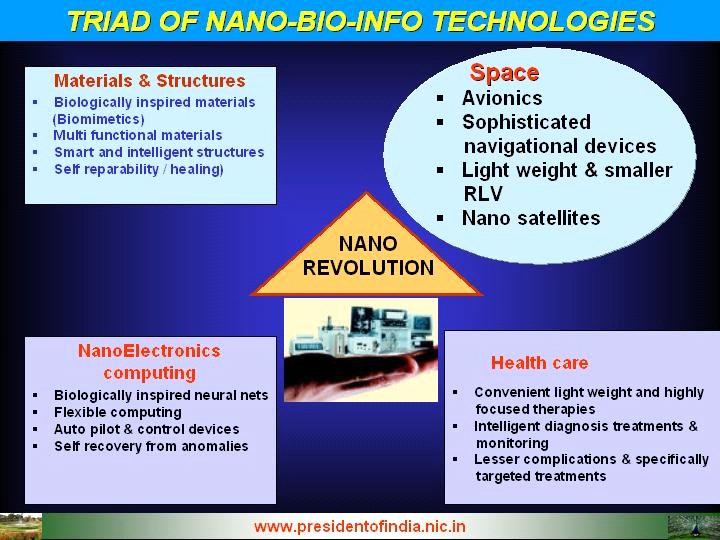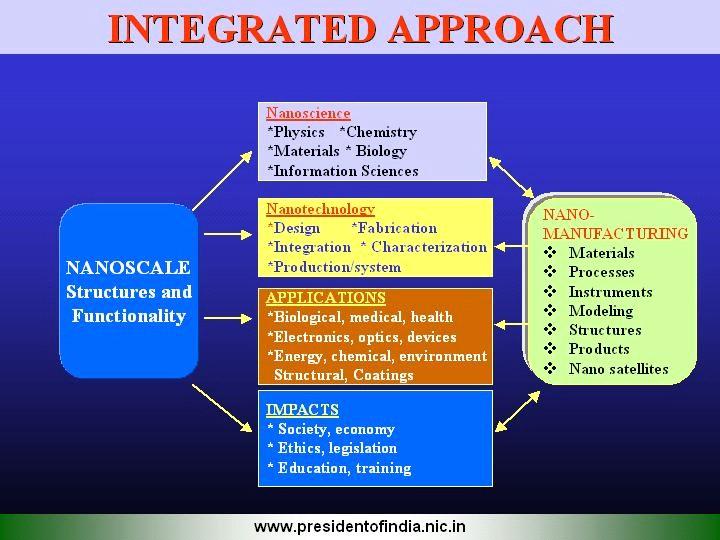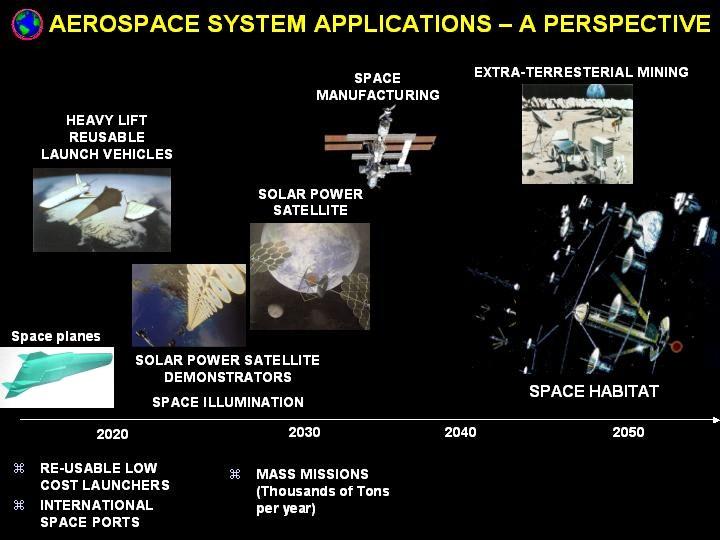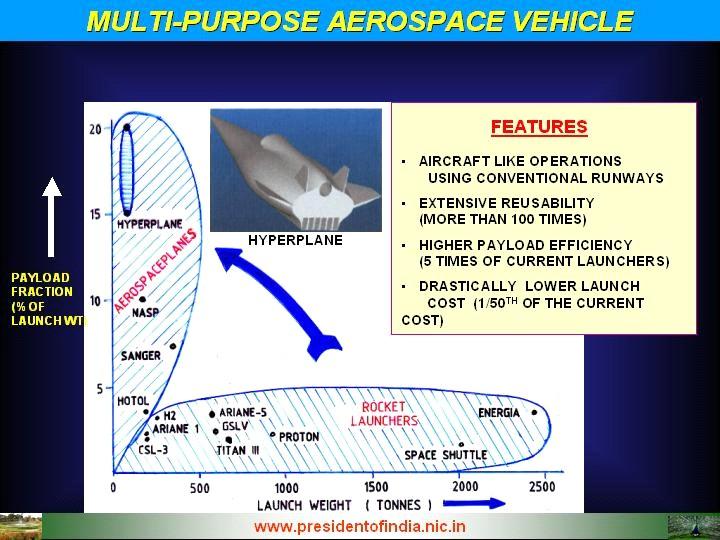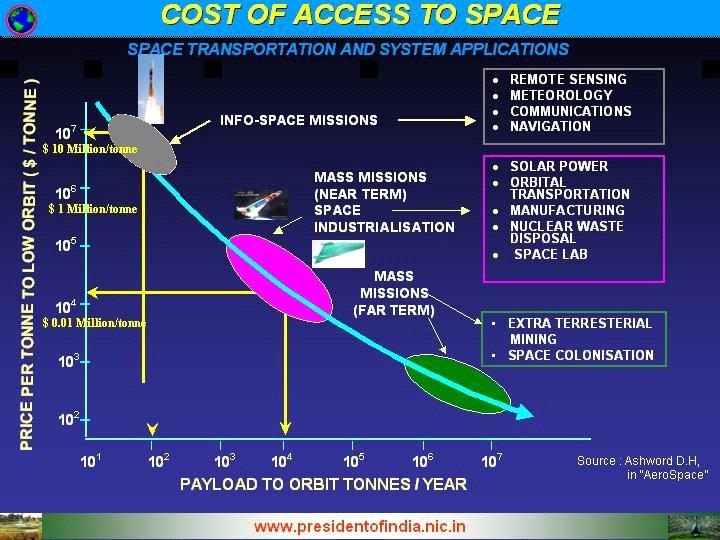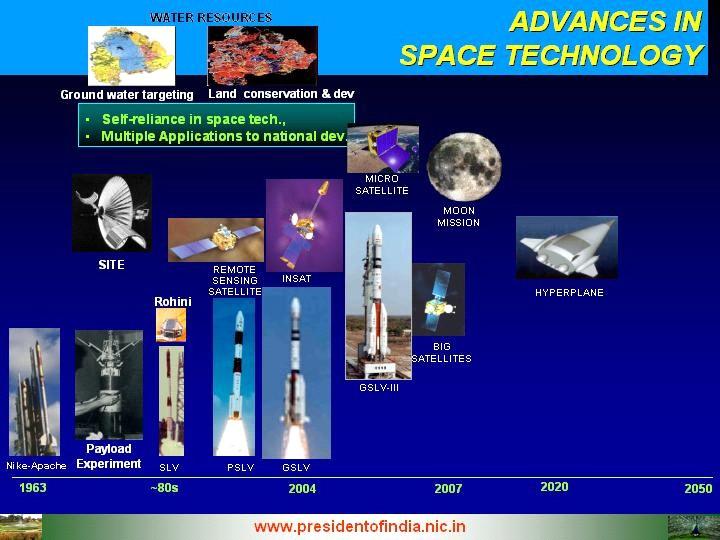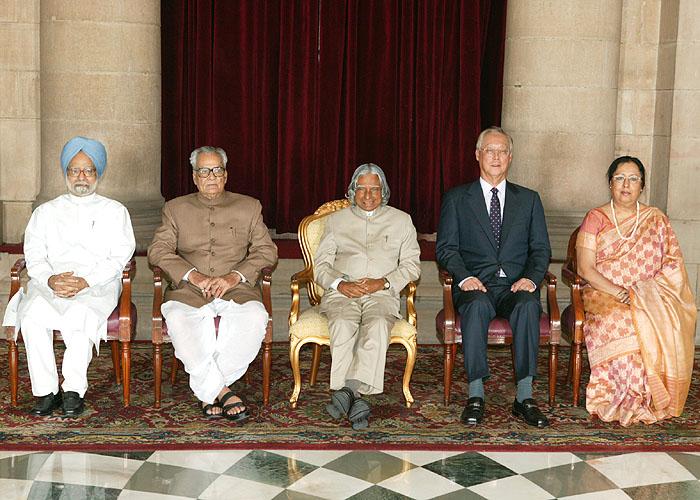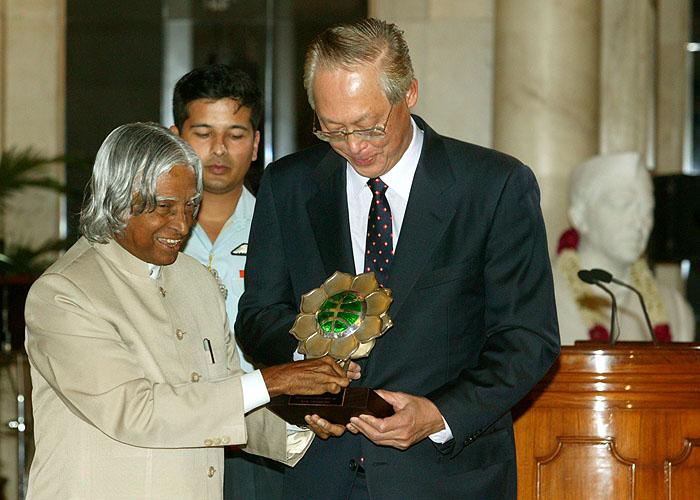Address To India-united States Conference On Space Science Application And Commerce: Strengthening And Expanding Co-operation(Through Video Conference), Bangloare
Bangloare : 25-06-2004
Dynamics of Indo-US Space co-operation
I am indeed delighted to participate in the Indo-US conference on Space science, application and commerce. Friends, the Indian and the US space teams have worked together for 16,000 to 20,000 hours for evolving cooperative space missions and programmes. It is heartening to note the scientists, administrators, and technologists of two nations meeting together to evolve a plan of action for a longstanding co-operation. I am sure you have done that. My greetings to all of you.
Commencement of Indo-US space cooperation in Thumba
Now, let me recall one event that took place four decades ago in Thumba, a small fishing village where the India?s space research programme was born. Let me describe the event at the payload integration laboratory. It was a round the clock operation for many weeks. Three space teams, two dealing with scientific payloads and the other dealing with rocket, payload and system integration were on the site. The rocket and payload team consisted of Robert Bessel from GSFC, Robert Duffy, Director, Wallops Island test range, Mr. Madhavan Nair, presently Chairman ISRO and myself. I was a rocket engineer at that time. The second team consisted of Prof. Blamount from CNES, France and Prof. P.D. Bhavsar, PRL, India for the Sodium Vapour experiment to study the upper atmospheric structure. The third team was of Prof. Satyaprakash for the Langmuir probe experiment to measure electron density in E-Layer. The Nike Apache rocket with this payload was launched successfully from Thumba equatorial rocket launching station. The flight data was monitored with multiple cameras, telemetry and radar stations. It was a beautiful successful experiment with the cooperation of three nations. India ? USA ? France.
Enriched experiences so far
In this gathering, I see many of the technologists, who worked in India?s SLV-3 developmental programme, which was launched successfully on 18th July 1980, injecting the Rohini satellite in the low earth orbit. It was the entry for India heralding the growth of launch vehicle programme.
Today India has the capability to build many types of satellite launch vehicles and multi mission spacecrafts for remote sensing, communication and meteorology. ISRO has also planned a mission of orbiting the payload around the moon for scientific observations. ISRO is also working on Reusable launch vehicle technologies. USA is indeed a leading nation in space research and space technology. With space research and space technology as its prime focus the US, has landed Rovers on Mars to discover hydro potential. India?s greetings for the success of all the space endeavours of the US. The test flight conducted by NASA using the scramjet engine in the hypersonic regime may lead to the development of reusable long duration hypersonic vehicle. From here, where do we go in the next four decades? What we will be doing from now till 2050, based on what you both the teams from India and US have already discussed in the last few days at Bangalore.
Challenge before us
Friends, for both India and the USA the challenges in front of you are many. Terrestrial optical communication is giving a challenge to the space communication with its low cost, high bandwidth and networking capability. For the remote sensing data, there is a great demand from many countries including the developing world, but affordability is still an issue. Space scientists and space technologists have to come up with new strategies to bring down the cost of launch and also cost per kg of orbital payload in less than a decade. Fortunately two technologies are unfurling for further investigation, development and application. One is the reusable technology with multiple launching capabilities and another is through Nano technology. For me, the space science, application and commerce will be complete only by taking into account the cost of launching and orbital payload in an integrated way, since science does not have geo-political barriers because space has no border and so is science.
Cost of access to Space
Expansion of man?s activities in Space can and must take place only in a global cooperative manner that will integrate all nations? Space capabilities to reduce Man-Planet conflict patterns. This calls for reduction of cost of access to space by several orders of magnitude.
Such a reduction can enable the global space community to move out of the present era of information collection missions into an era of mass movement missions. They can find solutions for energy, water and mineral crisis, which is likely to engulf humankind soon if we are stuck only to the planet Earth. Let me also address a few issues of immediate relevance to those of us living in the planet Earth. Mankind will continue here for many billion years. We need good life here too. In fact for many hundreds of years Earth will be the primary launch base for our planetary humans.
Cost reduction strategies
Formulating of societal missions would lead to better capacity utilization, and the creation of low cost space transportation. We have to evolve innovative design concepts for both small as well as large payloads into space. Both single and two-stage to orbit RLV concepts can be examined. The goal here is to reduce the cost of access to Space by one and two orders of magnitude. Even a small scientific breakthrough, for example, in air breathing propulsion systems may lead to a Space transportation revolution. The world Space community has a huge stake in such breakthrough research in advanced inter-disciplinary and inter-institutional collaboration. A global effort is thus needed to quickly demonstrate the technology for low cost access to Space.
Development of reusable launch system
The global space industry has had a forty-year period of unprecedented growth and prosperity. But as would be seen from the trends, global space markets are declining. The market is rapidly shrinking for information satellites. The geo-stationary orbit is nearly full, and new earth orbits need study and exploration, especially use of small satellites in equatorial low earth orbit. Currently, global space industry has a capacity to launch over 200 tonnes of satellites every year. However, the forecast is that projected demand will consume less than half of this established capacity. Thus a bitter price war is on to capture this limited market. The cost of access to space forbids further expansion of space activities.
The Indian concept of hyper-plane, a fully reusable system is an innovation in rocketry providing a payload fraction of 15%, drastically reducing the launch cost. Therefore, it is an opportune moment for India and US to work together and launch a major universal mission to share the benefit of space to the whole mankind.
Need for a long-term perspective and global Space missions
There is a need to decide on a long-term 50-year perspective from small scale technology demonstrations of re-usable launch vehicles through solar power satellite demonstrations and satellite constellations to heavy lift RLVs for large scale solar power satellites, space manufacturing and ultimately to space habitat and extra terrestrial mining. You are going to show case that in space ?Small is beautiful? ? small satellites for very big missions.
The urgent need is to design and develop a variety of fully reusable RLV technology demonstrators and thus give credibility to the whole concept of low cost access to Space. Joint effort and sharing of tasks will lead to reduction in development cost and availability of large manpower for the programme.
Integrated approach
One key building material for tiny machine is Nano tubes. It is built on an atomic scale and the Hexagonal patterns of carbon atoms for extremely strong and durable. It is said that a car made of Nano tubes would be stronger and more stable than a car made with steel. But would weigh only 50 pounds. A spacecraft made of Nano tubes could be of the size and strength of the space shuttle but weigh no more than a conventional car. Nano tubes can handle heat extremely well and can be assembled into a any types of shapes. The development of Nanoscale structures would need an integrated approach of Nano Science, Nano technology, Applications and Nano Manufacturing leading to its impact to the society.
Indo-US space scientists and technologists should join together and establish a linkage with the development of Nano technology in various forms leading to its application to space technology.
Integrating Space, Information, Nano and Bio-technology for Societal transformation
The national developmental challenges are many involving integrated action namely: Agriculture and Food Processing, Education and Health care, Information and Communication Technology, Infrastructure and self-reliance in critical technologies. As space technologists, you have the role to play in many areas like education, healthcare, disaster prevention & mitigation, e-governance, urban planning, rural communication, PURA (Providing Urban Amenities in Rural Areas) and importantly Interlinking of Rivers and so on. The future of space applications for the planet earth cannot be only in the expanded uses of the now-very conventional technologies for telecommunication and space imagery.
It lies in the integrated application of space technology with other technologies such as biotechnology, information technology and Nano-technology for innovative missions that must address pro-actively acute problems of rapid depletion of conventional energy sources, drinking water supplies, and deliver solutions for the man-planet conflict that has led to pollution, climatic change and degradation of ecology and the environment. Indo-US team can work together for making these societal missions a success in a time bound manner.
Earthquake prediction
In many places in our planet, we experience severe earthquakes resulting in loss of life, loss of wealth and in some cases it destroys the decades of progress made by the country and its valuable civilizational heritage. India has earthquake problems periodically in certain regions. US, Japan, Turkey, Iran and many other countries also suffer due to earthquakes.
Earthquake is a sub terrain phenomenon and predicting this from space observations would be a great challenge even with the combined power of the great space scientists of the two nations. But the future in this direction is not without hope. I am sure that if you all work with the determination that you have always exhibited, we will reach the light on the other side of the tunnel.
Earthquake phenomena in broader sense starts to produce some precursors before the final rupture, although this precursor generating pre-rupture stage is not usually regarded as part of an earthquake. The question is whether such precursor really exists or not. So-called pre-slip envisaged in the dynamic models of earthquake source is also a good theoretical possibility but its observation appears difficult. Precise geodetic measurement by GPS may succeed in the detection of the pre-slip. It seems that electromagnetic phenomena prior to final rupture may be promising.
According to the idea that earthquakes occur when the crust reaches a critical state, emission of electromagnetic signals before final rupture is theoretically plausible, notably in the ultra low frequency (ULF) range and very low frequency (VLF) range.
It is hoped that well organized electromagnetic monitoring may provide unique observational information on the pre-slips. Atmospheric/ionospheric anomalies still remains unresolved. Post earthquake disaster recovery, communication and damage assessment are also areas where space science and technology can quickly make its impact. We have to mount a joint research programme for evolving a systematic methodology for determining the effects leading to earthquakes. This planet will definitely remember all of you for this unique contribution of this century.
40 years looking back and forward from now
Ever since our cooperation has started, it was a challenging and happy 40 years, a learning curve, which both nations would cherish. I am also envisioning 40 years hence. It is nice to think of where we were and where we are heading. It is not essentially about our interplanetary missions, but what we can do to the society at large. ISRO has reached a take off stage in space science and technology and US is a big space power. Normally real cooperation comes between two countries based on their core competence. We should not build it merely on sharing the benefits of this space technology for the benefit of 1.3 billion people of India and US nearly one fifth of the people of this planet. We have to ask ourselves what will be the aspirations of our two countries by say 2010, 2015 and 2020. What are our problems? It is evident from the experience of the last century that when a few nations are technologically and economically advanced, their economy grows. Technology reaching to only their own people will not bring peace in the whole planet. Today with all the advances in science and technology, only one billion out of six billion people of this planet have drinking water. How can we imagine that 1.5 billion people of advanced nations can have peaceful life, if 4.5 billion people of less developed nations are below poverty line and are not happy. All the more it is important that two big democracies of the world have to think how the space science technology and commerce can bring about global economic prosperity and global peace. Can space technology and applications effectively contribute towards peace mission?
I visualize in the year 2050 an Indo-US team establishing a habitat in Mars, establishing mining industrial units in space and working on a joint programme to destroy or deviate the asteroids when the earth is endangered. What a beautiful mission, purposeful mission for both the countries, India?US, with many countries as partners. We will have a voyage, a purposeful voyage and a challenging journey, above all a symbiotic revolution in the evolution of Nano-structured satellites and Nano devices and computers in the space systems. Friends, are we ready for such a voyage?
Conclusion
I suggest a 5-point space missions for the consideration by Indo-US space community
1. Bring down the cost per kg launch of payload. This can be done only with the use of reusable technology with oxidizer generation during the flight by mass addition and use of new materials.
2. Spacecraft weight should be brought down substantially using Nano technology in composite structures, electronics, computing and protective coating. This reduction in launch weight will add to the payload.
3. Intensive partnership between the two countries for generating power using SPS and the Space exploration, particularly mining of minerals by space industries from moon, asteroids and establishment of first habitats in Mars.
4. In 10 years period, that NASA and Indian Space scientists and technologists in collaboration with geologists of respective countries will be capable of predicting earthquake at least a week ahead, similar to cyclone prediction now. It will need intensive research in the area of Geomagnetics and related instrumentation.
5. The benefits of space research should reach the six billion population by providing them with unhindered supply of safe drinking water, shelter, food, healthcare and education so that we will have a peaceful, happy and prosperous world.
Thinking beyond our planet is an essential trait. The thought itself elevates the person. The person is transformed into a creative state. Creativity indeed is the foundation of discovery and inventions. May God bless you.
Note: If you have any queries on this topic 'Dynamics of Indo-US Space Cooperation', you may interact with me through my website www.presidentofindia.nic.in till 25 JUL 2004.

